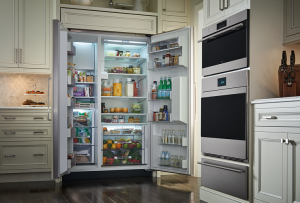1. Check the Refrigerator Seal
Every refrigerator door has a seal or gasket that is designed to make the door airtight. If there are any gaps in the seal, the cooling capabilities of the fridge will be compromised. Take a dollar bill, close the refrigerator and push the bill in the door seal. If the seal holds the bill, it’s tight enough, if it falls out or is easy to pull free, the seal is too loose. The door seal will need to be replaced, but check it first for any obstruction that could be the cause of the fault. A useful temporary fix is to apply a thin layer of Vaseline on the seal section that is not providing an adequate seal.
2. Check the Coils for Dust
The condenser coils, located at the rear of the refrigerator, are vital to the cooling process. Over time they can be covered with dirt or dust that will affect how well they can work. This is especially true if you have pets that shed hair in your home or if you have dust bunnies which can easily form at the back of appliances. Newer refrigerators often have self-cleaning condenser systems, but older models need to be cleaned. The dust can be removed with a vacuum attachment, or you could purchase a special coil brush.
3. Keep the Fridge Well Stocked
It may seem that a fridge needs to work harder if you put more food in it. This is incorrect, and in fact, the exact opposite is true. A well-stocked refrigerator uses less energy compared to an almost empty fridge. Of course, it would be crazy to buy a load of food that you cannot eat or stock-up before going on a summer vacation. If you want to keep the fridge full and don’t want to buy more food, simply fill up the empty spaces with pitchers of water instead.
4. Set the Correct Temperature
Both the fridge and the freezer need to be set to the correct temperature for optimal performance and energy efficiency. This will help you to keep your food stored safely without breaking the bank. A refrigerator section should be kept between 35 to 38 degrees, and the ideal freezer temperature is 0 to 5 degrees.
5. Change the Water Filter
If you have a water filter in your refrigerator, make sure that it’s replaced regularly. Most modern refrigerator models have a filter indicator that will tell you automatically when a change is needed. If you don’t have this feature, it’s a good rule of thumb to replace your water filter twice each year. This can vary depending upon your refrigerator model, so always consult the owner’s manual for more specific details. A clean water filter will provide cleaner water and ensure that your ice maker is running more efficiently.
If your refrigerator is struggling to cope with the summer heat and you’re considering an upgrade, you can explore your options with this online refrigerator collection, or speak to a home appliance repair expert for any repair needs.
